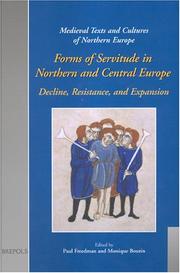| Listing 1 - 1 of 1 |
Sort by
|

ISBN: 9782503516943 9782503539102 2503516947 Year: 2005 Volume: 9 Publisher: Turnhout Brepols
Abstract | Keywords | Export | Availability | Bookmark
 Loading...
Loading...Choose an application
- Reference Manager
- EndNote
- RefWorks (Direct export to RefWorks)
It was once assumed that nearly all agricultural labourers in medieval Europe were serfs. Serfdom was distinct from slavery in that serfs could contract legitimate marriages, hold personal property and could not be moved around at will. Historians more recently moved away from examining servile condition and its implications and focused on the seigneurial regime and village society with little regard for the influence of status.In the Middle Ages and indeed in all pre-industrial societies, the vast majority of the population tilled the land. We are still not in a good position to evaluate how noble and ecclesiastical landlords received revenues from lands they were only indirectly engaged in farming, despite this being a basic factor that governed medieval society. What kind of agricultural system provided the impetus for economic growth that so dramatically increased the number of cities and volume of trade?There is no modern, synthetic book on medieval serfdom that compares regions or draws general conclusions about it. This work attempts such a synthesis and also shows avenues of future research, but most importantly it is intended to reorient attention to the importance of serfdom in the structure of medieval society.
Land tenure --- Land tenure. --- Leibeigener. --- Leibeigenschaft. --- Peasants --- Peasants. --- Serfdom --- Serfdom. --- History --- Geschichte 1200-1600. --- To 1599. --- Europe. --- Germany. --- Göttingen <2003>. --- Mitteleuropa. --- Nordeuropa. --- Peasantry --- Agricultural laborers --- Rural population --- Marks (Medieval land tenure) --- Villeinage --- Servitude --- Forced labor --- Slavery --- Agrarian tenure --- Feudal tenure --- Freehold --- Land ownership --- Land question --- Landownership --- Tenure of land --- Land use, Rural --- Real property --- Land, Nationalization of --- Landowners --- Law and legislation --- Acqui 2006 --- Servage --- Histoire --- Europe
| Listing 1 - 1 of 1 |
Sort by
|

 Search
Search Feedback
Feedback About UniCat
About UniCat  Help
Help News
News